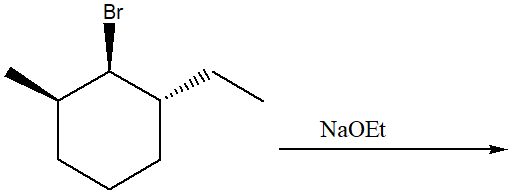Br E 2 chair Na OEt E2 transition state E2 Product 1. what is the chair conformation of the cyclohexane that can undergo elimination? 2. what is the transition State for E2 elimination reaction? 3. What is the Ez elimination Product? 4. Would the Solution of the product be optically active or not?
Br E 2 chair Na OEt E2 transition state E2 Product 1. what is the chair conformation of the cyclohexane that can undergo elimination? 2. what is the transition State for E2 elimination reaction? 3. What is the Ez elimination Product? 4. Would the Solution of the product be optically active or not?
Chemistry
10th Edition
ISBN:9781305957404
Author:Steven S. Zumdahl, Susan A. Zumdahl, Donald J. DeCoste
Publisher:Steven S. Zumdahl, Susan A. Zumdahl, Donald J. DeCoste
Chapter1: Chemical Foundations
Section: Chapter Questions
Problem 1RQ: Define and explain the differences between the following terms. a. law and theory b. theory and...
Related questions
Question
I need help with the second and third portion of this assignment

Transcribed Image Text:A) What are the major product for each reaction
B) For each reaction, What will proceed SNI, SNQ, El, or E2 mechanism
How can you explain your answer choice by providing the following
points type of halide, type of nucleophile and base, type of solvent.
ос
c) which major Product will be optically active and which one are not.
What is the reason for each answer choice?
o
Br
E 2 chair
вс
NaOH
DMF
коево
Na O Et
>
вс
|||| C/
II
+==N
1. Equiv. Na
acetone
EtoH
heat →
(give the substitution product)
E2 transition state
E2 Product
1. what is the chair conformation of the cyclohexane that can
undergo elimination?
2. what is the transition State for E2 elimination reaction?
3. What is the E2 elimination product?
4. Would the Solution of the product be optically active or not?

Transcribed Image Text:Where are the curved arrow mechanisms locate? In each step, indicate
the Lewis acid and Lewis base and wheather they are Bronsted
acids and Bronsted bases
5. What is the number of transition States and the number of intermediate
in the mechanism
C. What are all of the reasonable resonance contributors.
=
c
CH3OH
heat
OCH 3
O
Expert Solution
Step 1
B. Given that, a reaction scheme is shown below

We have to draw the chair form of the reactant, the transition state for the E2 elimination reaction, and also have to draw the structure of the product.
Introduction: During the E2 elimination reaction always the anti elimination reaction takes place.
N.B.: According to the Bartleby Q&A guidelines, we have to answer only one question. So, kindly post the remaining question.
Trending now
This is a popular solution!
Step by step
Solved in 3 steps with 4 images

Knowledge Booster
Learn more about
Need a deep-dive on the concept behind this application? Look no further. Learn more about this topic, chemistry and related others by exploring similar questions and additional content below.Recommended textbooks for you

Chemistry
Chemistry
ISBN:
9781305957404
Author:
Steven S. Zumdahl, Susan A. Zumdahl, Donald J. DeCoste
Publisher:
Cengage Learning

Chemistry
Chemistry
ISBN:
9781259911156
Author:
Raymond Chang Dr., Jason Overby Professor
Publisher:
McGraw-Hill Education

Principles of Instrumental Analysis
Chemistry
ISBN:
9781305577213
Author:
Douglas A. Skoog, F. James Holler, Stanley R. Crouch
Publisher:
Cengage Learning

Chemistry
Chemistry
ISBN:
9781305957404
Author:
Steven S. Zumdahl, Susan A. Zumdahl, Donald J. DeCoste
Publisher:
Cengage Learning

Chemistry
Chemistry
ISBN:
9781259911156
Author:
Raymond Chang Dr., Jason Overby Professor
Publisher:
McGraw-Hill Education

Principles of Instrumental Analysis
Chemistry
ISBN:
9781305577213
Author:
Douglas A. Skoog, F. James Holler, Stanley R. Crouch
Publisher:
Cengage Learning

Organic Chemistry
Chemistry
ISBN:
9780078021558
Author:
Janice Gorzynski Smith Dr.
Publisher:
McGraw-Hill Education

Chemistry: Principles and Reactions
Chemistry
ISBN:
9781305079373
Author:
William L. Masterton, Cecile N. Hurley
Publisher:
Cengage Learning

Elementary Principles of Chemical Processes, Bind…
Chemistry
ISBN:
9781118431221
Author:
Richard M. Felder, Ronald W. Rousseau, Lisa G. Bullard
Publisher:
WILEY